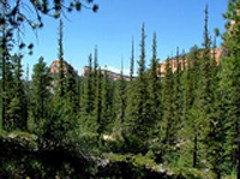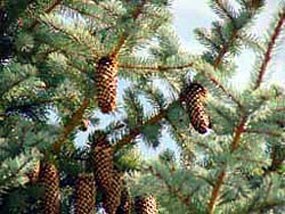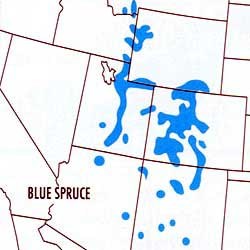What Is the Scientific Name for Blue Spruce
Common Names: Blue Spruce, Colorado Blue Spruce
Scientific Name: Picea pungens Size (height & diameter) English & Metric: 70-100 ft (21-30 m) tall, trunks 18-36" (.5-.9 m) in diameter
Habitat: Along mountain streams
Flowering Season: N/A, not a flowering plant
Range: Central Rocky Mountains

lee dittman
General Description:
Blue Spruce (Picea pungens), the state tree of Utah, is found primarily in moist soil and along streams, from 8,000-11,500 ft., often at the bottom of ravines. Since flowing water is a rarity at Bryce Canyon, this is our least abundant member of the Pine Family.
This species can overlap with Englemann Spruce, Picea englemannii, but the orange coloration of mature Englemann Spruce bark is a dead giveaway. The other sure comparison is to grab both species' boughs. If you jerk your hand back exclaiming "Ouch!" then it was probably an Englemann Spruce. If, however, you exclaim "Ouch!..." followed by a string of expletives, then it was probably a Blue Spruce. Blue Spruce needles are rigid, sharply pointed, and diamond shaped in cross-section. Like real needles, they can easily break the skin. Blue Spruce needles are bluish green with silvery undersides.
The needles are attached to a peg-like projection from the twigs which give the twigs a prickly texture even after the needles have fallen off. The bark is pale to dark gray and furrowed. It bears cones over 3 inches long, whose scales are thin, papery, and hang downward from upper branches. Seeds are dispersed by the wind prior to the cones being dropped.

Plant Lore:
Blue Spruce is highly prized as an ornamental tree for home and commercial landscaping. It so happens that this tree requires almost the same amount of water as Kentucky Blue Grass, so if you can maintain a lawn, you can take care of a Blue Spruce.
The horticulture industry has experimented with various strains trying to increase or decrease the amount of silver in the underside of the needles, often inventing unofficial and confusing common names for marketing purposes and to add legitimacy to their efforts. Furthermore, this species is also a very popular "Christmas tree" both for its beauty and its prickly protection of fragile and expensive ornaments placed where young hands might otherwise play with them.
Conservation Message:
Blue Spruce is seldom found in places where heavy grazing occurs as the saplings are quickly consumed by livestock, which is a concern for the regeneration and sustainable supply of the species. On the other hand, it has become so popular commercially that it could be said that the range is expanding. Fortunately for the other species living in the areas in which it has been introduced as an ornamental, it does not compete well with the native kinds of trees.

When and where to see at Bryce:
Normally you'd look for Blue Spruce where there is flowing water. However don't be fooled by the creek that runs by Mossy Cave. This is actually an irrigation ditch that is shut off in the winter and consequently doesn't sustain the plant communities you might expect it would. A better place to look for Spruce is along the Swamp Canyon Loop and in the backcountry in the occasionally shady pockets at the bases of cliffs where springs seep out from the rock.
Further Reading:
Buchanan, Hayle. 1992. Wildflowers of Southwestern Utah. Bryce Canyon Natural History Association. Bryce Canyon, Utah
Lanner, Ron. & Rasmuss, Christine. 1988. Trees of the Great Basin: a Natural History. University of Nevada Press
Little, Elbert L. 2001 National Audubon Society Field Guide to Trees - Western Region. Random House Inc. New York, NY
Stuckey, Martha & Palmer, George. 1998. Western Trees: A Field Guide. Falcon Publishing, Inc. Helena, MT
Source: https://www.nps.gov/brca/learn/nature/bluespruce.htm
0 Response to "What Is the Scientific Name for Blue Spruce"
Post a Comment